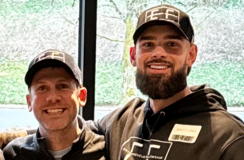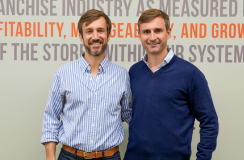osh Paulson never knew much about his grandfather’s business, Quality Cage — until he took it over.
Josh had dabbled in a few industries, but after growing up a big dreamer, he had been directionless for a while. Addicted to drugs and feeling suicidal, he thought about what his 10-year-old self would think of the way he’d turned out.
He realized he wanted to change.
Josh started trying to raise capital for a mushroom-growing venture. When a potential investor recommended he first run a business for six months to gain experience, Josh thought of Quality Cage.
At the time, his grandfather’s health was declining, and the family was preparing to wind down the business. Josh asked if he could run it for six months, and they agreed.
Overnight, Josh packed up and moved from Boise to Portland. When he got there, he found that there were no profits, the prices were too low, and the inventory too wide. The 42-year-old business had 42 years of waste and bloat.
Josh got to work learning the business. He cut down the product line, set up operational processes, and brought as much of the manufacturing in-house as possible.
After those initial six months, working almost alone, he decided to acquire Quality Cage outright from his grandfather. Over the next five years, the business saw around 35% to 50% growth per year. Now that the business is on solid ground, Josh has plans to start diversifying the product line.
In this episode, Josh talks about reluctantly taking over the business in hopes of starting a new life, and learning everything about running the business from someone who didn’t speak much English. He also offers advice for anyone who wants to go into manufacturing with no experience.
Check out:
✳️ Top takeaways from the episode
✳️ Episode highlights with timestamps
✳️ Links & mentions

Acquisition Entrepreneur: Josh Paulson
💵 What he acquired: Josh Paulson saw his grandfather’s pet cage-manufacturing business, Quality Cage, as a way to prove his mettle to investors he was courting for a separate venture, his own mushroom-growing business. His family was trying to close Quality Cage, but Josh persuaded them to let him run it for six months. When the time was up, instead of going back to the investors to pursue his mushroom venture, Josh acquired Quality Cage. Over the last five years, the business has grown 35% to 50% every year.
💡 Key quote: “[Manufacturing is] very, very hard. If you want to learn it yourself, it's a long route. Not to put down marketing, but anybody can learn marketing in a year. I've been in this business for seven years, and something new comes up all the time.”
👋 Where to find him: Twitter | LinkedIn

Acquisition Tips From the Episode
Top takeaways from this conversation
✂️ When the business is doing too much, simplify.
When Josh took over the company, there were around 2,000 SKUs. The products that were selling well were unfortunately the less profitable ones. For example, rabbit cages. Since rabbits are inexpensive, people don’t want to spend a lot of money on their cages.
However, Josh saw potential in one product in particular: chinchilla cages. Demand for these cages was growing, with no marketing push, and the margins on them were higher.
“A chinchilla is $300, so I can sell a $600 cage to a chinchilla owner,” Josh says. Plus, chinchilla owners are known to be very committed to their pets, and happy to spend money on them.
With this insight in hand, Josh cut the other products and focused exclusively on the chinchilla market. Another advantage of this approach was that it helped to simplify his manufacturing processes.
👍 The nature of manufacturing businesses.
There are two ways to run a manufacturing business: Pay an experienced operator, or learn to do it yourself.
If you choose the latter route and you’re new to this type of business, be prepared for a steep learning curve.
Josh says that despite owning Quality Cage for seven years, he’s constantly challenged by new obstacles. For example, when there’s only one supplier available, supply chain issues really compound. When that happens, Josh and his team either have to redesign the product completely, or start making that part themselves.
“There's nothing cookie cutter about manufacturing. It's a lot of businesses all rolled into one, essentially,” Josh says. “The hardest part is you've got to be willing to bite the bullet and do things yourself.”
💸 Base your pricing on the margins you want to make.
One of the biggest pieces of advice Josh wants to give manufacturing entrepreneurs is to know what kind of margin you want and set your pricing to that. He says he thought about raising prices for six to nine months, but kept deciding against it. He hoped to improve profitability by streamlining the manufacturing process instead.
When that wasn’t working, Josh finally decided to raise all of the prices by 20%. While there was some backlash, those customers weren’t Josh’s kind of customer anyway. His only regret was not doing it sooner.
“I could probably have erased two years of self-torment by just raising my prices on day one,” Josh says.
Episode Highlights
Inflection points from the show
[2:04] Mushroom for improvement: Josh never saw himself becoming an entrepreneur. He did try to start a mushroom venture, but found it was very capital intensive. Thinking about the different jobs he had over the years, he sees there were opportunities for him to step into a leadership role, but he was too focused on trying to do his own thing.
[5:52] Life-changing moment: In 2015, Josh was dealing with depression, anxiety, addiction, and suicidal thoughts. During one suicidal moment, he thought about the dreams he’d had as a kid, and what the 10-year-old version of himself would think about himself in the present day. He realized he needed to make some changes to his life.
[8:28] Opportunity knocks: When a potential investor for the mushroom business told Josh to get six months’ experience running a business, Josh convinced his family to let him take over his grandfather’s pet cage-manufacturing business, Quality Cage. The family was trying to close it, but they let him try.
[10:41] Making a move: Josh moved from his home in Boise, Idaho, to run the business in Portland, Oregon. He had no money, so he lived in the warehouse. The business was making revenue but wasn’t profitable. Josh immediately began making changes.
[11:57] Bad books: Even with no experience with bookkeeping, Josh could see that the books were a mess. The business was doing about $250,000 a year and had seven employees. There was no information about cost of materials or production, and no processes in place.
[15:41] Unlikely resources: As Josh focused on rebuilding the business, he let go of most of the employees. The only person he kept on was a 75-year-old Vietnamese man who spoke very little English but knew how the business worked. Josh spent the next year learning everything about Quality Cage from him.
[18:57] Simplify: The business had 2,000 SKUs, and only one of each product in stock. The chinchilla product line was a relatively small part of the overall business, but was growing on its own and had a higher profit margin. Josh decided to cut most of the other products and focus the business on the chinchilla market.
[24:14] The difficulty of manufacturing: Josh wasn’t just learning about Quality Cage: He also had to learn about manufacturing, specifically the high mix, low volume kind of manufacturing the business was built on. Josh speaks to the difficulties of managing that process.
[25:49] Taking the plunge: When Josh signed on to run the business, he was only planning on putting in the six months he needed to make his mushroom venture happen. He wasn’t planning on actually acquiring the business. However, he ultimately decided to go for it. Taking over the business allowed Josh to get out of the situation he was in and move forward. He was completely changed by the experience.
[31:23] The acquisition: Josh tried to find the cheapest way possible to acquire Quality Cage. He ultimately started a new business and acquired Quality Cage’s assets at fair market value. Simply put, instead of paying money for the business, he took on the business’s debt. It sounded good at first but has proven to be the wrong approach.
[33:05] More moving: After a year of running Quality Cage, Josh moved the business from Portland back to Boise, where his family, friends and support system were. But Boise isn’t the best place for labor. Later, Josh moved again, to Austin, Texas, in early 2020, which allowed him to cut shipping and other costs.
[35:23] Dreaming big again: The business is still making less than $1 million annually. Thanks to the move, Josh wasn’t able to capitalize on the growth the business experienced during the COVID-19 pandemic as much as he would have liked. However, he says the business is getting closer to that goal, and growing 35% to 50% every year.
[36:44] Working solo: Josh recalls that in his first days of running Quality Cage, he was working 16-hour days as the only employee. He learned welding, manufacturing, marketing and shipping, and did it all by himself until he paid off the business’s debts.
[38:17] Expanding the product line: Now that the business is on more stable ground, Josh feels comfortable introducing additional products. Its latest product line focuses on rabbits, and he’s also introduced custom cage design.
[42:12] Labor of love: For those who are considering acquiring a manufacturing business, Josh’s advice is that you need to be enthusiastic about it. It’s a long and complicated process, and if you don’t have a baseline of understanding or at least a passion, you won’t be able to stay the course.
[46:06] Pricing is key: Another piece of advice from Josh is to set your pricing according to the margins you want. Reverse-engineer your business operations from there. You can always raise prices later.






%20-%20thumbnail.png)

.png)




%20-%20thumbnail.png)















%20-%20thumbnail.png)














































































